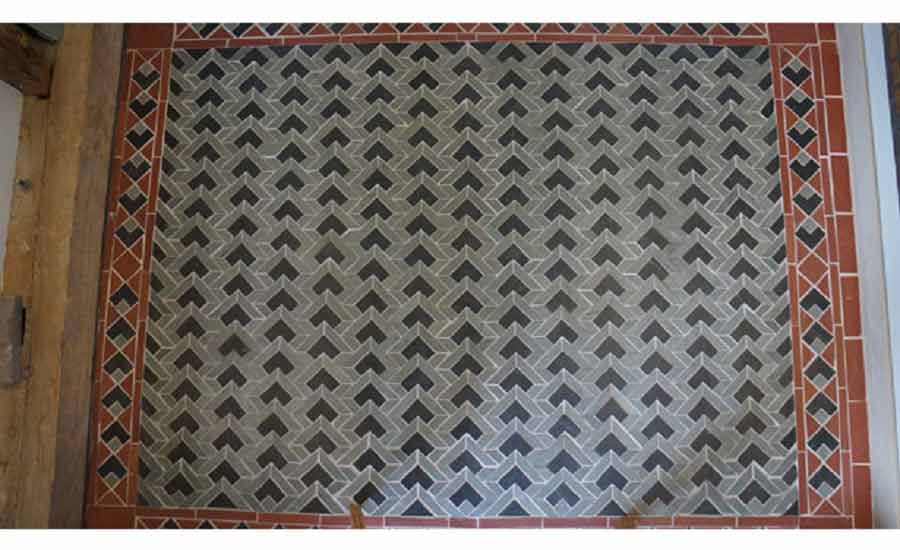What is the best way to clean a gray slate floor? It streaks every time I mop it, and the mop seems to shed on the floor.
It sounds as though your slate floor has a rough finish, which catches the fibers of the mop as it is dragged across the floor. First, you need to deep clean the floor to remove all dirt and grime. Next, apply a high-quality acrylic sealer. Several coats may be necessary. The acrylic sealer should make future cleaning much easier. Clean the floor with a neutral cleaner and re-apply the sealer as needed.The slate steps on our front porch have developed a hard white deposit coming from the grout lines. How can we clean it off?
The white deposits are salts, which are bleeding through from the grout joints or from the mortar. An acid wash will be required to remove the salts. If the deposits are heavy, try scraping them off before washing the slate with acid. Several acid products are available for this purpose. Ask your local stone supplier.
What's the best way to remove a polyurethane finish that was placed on my slate floor?
Unfortunately, most polyurethane finishes require strong solvent-based chemicals for removal. Methylene-chloride strippers as well as a number of safe strippers are available, but be forewarned: removing polyurethane is a messy job. I know several professionals who refuse to do it.
I have recently laid a black river slate floor. Having grouted the floor with the slurry method, I discovered that the surface of the majority of tiles had grout in the recesses and the cracks. Now the black slate floor has white lines across it. How do you rectify this?
While I do not normally recommend using acids on any slate surface, this is the one exception. Try washing the floor with a solution of sulfamic acid. You can find this acid at most home centers and tile supply stores. After rinsing the floor with acid, make sure to rinse with plenty of clean water.
I have a slate floor that has a few scratches from what looks like something being dragged across it. They're fairly light, but stand out because they run the entire length of the floor. Do you have any suggestions on how to fix this? Will resealing the floor help blend them?
It is possible that a topical sealer would hide the scratches, however, to remove them entirely, the floor will need to be resurfaced. If the slate has a natural cleft finish - that is, if the texture of the slate is uneven - then the floor should not be resurfaced. Your only option would be to try and hide the scratches with a topical coating.
I have a slate floor that we just removed carpet from. We also rented a floor sander and sanded off most of the glue and paint from the slate. My original plan was to seal the floor, as is, but the carpet padding left a black tire-like imprint on most of the floor. It is very difficult to remove, and I'm wondering if a stain will cover it. Can I stain over this waffle print on the floor, or do I need a specific cleaner? I tried Jasco epoxy remover, but had no luck. While the sanding removed some of it, much of the imprint remains. Also, there is a large crack going across the floor. Will this seal okay?
Chances are a stain will not cover the pattern left by the carpet. I would try resanding the floor again with a more aggressive grit. You should not use a wood floor sander. I would recommend using a single disc 175-300 rpm floor buffer with diamond pads. This is a task for a professional, and I would consider hiring a professional contractor to do the work. For a list of contractors in your area visit the contractor directory at www.ntc-stone.com.
How does boiled linseed oil work for sealing slate and grout? I tried some on a piece of slate, and it really brought the color out. Does anyone have any experience with this and/or its long-term results?
Although boiled linseed oil works as a color enhancer, I would generally not recommend it. The oil acts as a dirt magnet, and it will attract dirt, making it difficult to keep the floor clean. If you want to use any coatings, the linseed oil will prevent the coating from adhering. There are products available that will enhance the color as the linseed oil does, without the negative side effects.
I have a slate floor that years ago was waxed many times with a product called Mop n' Glo. I have tried every thing I can think of to remove this. Some of it has worn off, but around the edges of the room, it is dark and dirty. Any clue as to how I can remove this would be greatly appreciated.
Unfortunately, you will need to get a commercial wax stripper to remove the build up. Check in your local Yellow Pages under janitorial supplies.
A friend, with the help of a hired laborer, recently completed laying a slate patio on a cement slab. The laborer is recommending a 3% muriatic acid wash before sealing. The supplier of the slate recommends a different bottled product to wash the slate and then neutralizing the acid with another product, all before sealing. What is the correct way to proceed? Is there a particular type of sealer you would recommend?
You need to be very careful using an acid to wash slate. If you think an acid is needed, use a mild acid such as sulfamic acid. I would not use hydrochloric acid. The only reason to use an acid would be if there is a grout or mortar film on the slate. If there is no film, an acid wash is not needed. In this case, simply clean the slate with a neutral cleaner and allow it to dry for at least 24 hours. Apply a sealer designed for use on slate.
I am going to put 600 square feet of slate on my new floor. I was wondering if there really is a quality difference in the tile you get for $2.00/square foot at the giant home centers versus the tile you get for $5.00-$7.00 from the local tile store. I don't want to be cheap, but I also don't want to just spend money to spend money.
Slate is a natural stone product. Depending on where the slate is quarried, you can have major differences in how it will hold up. Examine the slate carefully and make sure it is sound and does not easily flake. Ask where the slate is from and compare it to the more expensive slate. Don't be afraid to ask the salesperson, What is the difference? You might be able to make a decision based on his answer.
I am trying to clean an old slate floor. The slate has some type of sealer or wax, which is very dirty and discolored. I have tried many types of cleaners and strippers. I have found one solvent product (xylene), which removes the wax or sealer, but leaves the slate dull. I have two concerns: Will the xylene solvent damage the slate, and how do I restore the shine to the slate?
The xylene is a solvent that can be dangerous to work with. It will not harm the slate. My suggestion would be to use one of the safe strippers available. To restore the shine, you will need to coat it with an acrylic-based finish.

